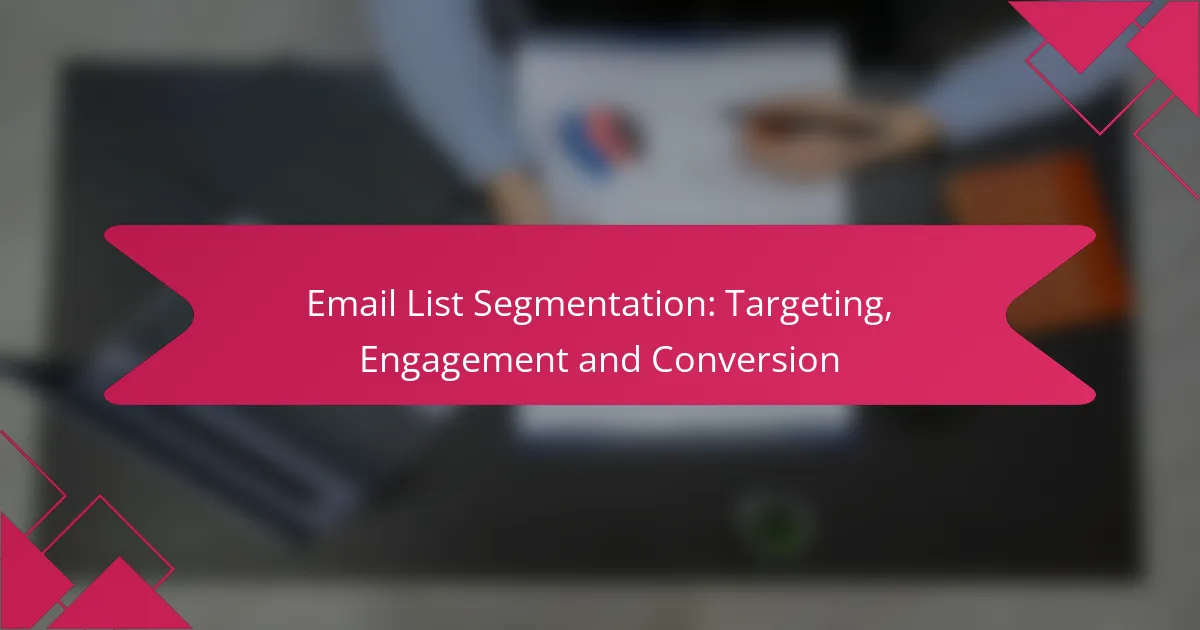A/B testing email subject lines is a crucial strategy for enhancing engagement and open rates. By understanding your audience and tailoring your approach, you can effectively identify which subject lines resonate best. Incorporating best practices such as personalization, testing different lengths, and utilizing analytics tools will further optimize your email marketing efforts.

How to improve A/B testing for email subject lines in Canada?
Improving A/B testing for email subject lines in Canada involves understanding your audience and tailoring your approach to their preferences. Focus on personalization, testing various lengths, using emojis wisely, and analyzing send times to optimize engagement.
Use personalized subject lines
Personalized subject lines can significantly enhance open rates by making recipients feel valued. Incorporate the recipient’s name or relevant details about their previous interactions with your brand. For instance, “John, your exclusive offer awaits!” can be more compelling than a generic subject line.
To maximize effectiveness, consider segmenting your audience based on demographics or behavior. This allows you to tailor messages that resonate more deeply with specific groups, improving overall engagement.
Test different lengths
Subject line length can influence open rates, so it’s essential to test various options. Generally, shorter subject lines (around 6-10 words) tend to perform better on mobile devices, while longer ones may be more effective on desktop. Experiment with different lengths to find what resonates best with your Canadian audience.
A good practice is to create a mix of concise and descriptive subject lines in your A/B tests. This way, you can analyze which style garners more attention and adjust your strategy accordingly.
Incorporate emojis effectively
Using emojis in subject lines can add a playful touch and attract attention, but they should be used judiciously. Emojis can help convey emotion or urgency, such as “Don’t miss out on this deal! “. However, overusing them can make your emails appear unprofessional.
Test the impact of emojis on your open rates by comparing subject lines with and without them. Keep in mind that cultural perceptions of emojis may vary, so ensure they align with your brand voice and audience preferences in Canada.
Analyze timing of sends
The timing of your email sends can greatly affect open rates. Analyze when your audience is most likely to check their emails, which may vary by demographic or industry. For example, sending emails during weekday mornings or early afternoons can yield better results than late evenings or weekends.
Conduct A/B tests to determine optimal send times for your specific audience. Track engagement metrics to refine your strategy, ensuring that your emails reach recipients when they are most receptive.

What are the best practices for A/B testing email subject lines?
To effectively A/B test email subject lines, focus on clear objectives and systematic execution. This approach helps identify which subject lines resonate better with your audience, ultimately improving open rates and engagement.
Define clear goals for each test
Establishing specific goals is crucial for A/B testing email subject lines. Common objectives include increasing open rates, enhancing click-through rates, or driving conversions. By defining what success looks like, you can measure the impact of each subject line accurately.
For example, if your goal is to boost open rates, track the percentage of recipients who open the email after receiving different subject lines. This clarity will guide your testing process and help you make informed decisions.
Segment your audience appropriately
Effective segmentation of your audience can lead to more relevant A/B tests. Consider factors such as demographics, past behavior, and engagement levels. Tailoring your subject lines to specific segments can yield more meaningful insights.
For instance, you might test different subject lines for new subscribers versus long-term customers. This ensures that the messaging aligns with the interests and expectations of each group, leading to better results.
Use a control group for comparison
Incorporating a control group is essential for valid A/B testing. The control group should receive the original subject line, while the test group receives the variations. This comparison allows you to assess the effectiveness of the new subject lines against a baseline.
For example, if you are testing two new subject lines, keep one version unchanged as the control. This method provides a clear reference point, helping you determine whether the changes made a significant impact on performance.

What tools can assist with A/B testing email subject lines?
Several tools can enhance A/B testing for email subject lines, helping marketers optimize engagement. These platforms provide features for creating variations, analyzing performance, and integrating insights into future campaigns.
Mailchimp for email campaigns
Mailchimp is a popular choice for managing email campaigns and offers built-in A/B testing features. Users can easily create different subject lines and send them to segmented lists to determine which performs better.
To maximize effectiveness, consider testing subject lines with varying lengths, tones, or personalization. For example, a subject line with the recipient’s name may lead to higher open rates compared to a generic one.
HubSpot for analytics
HubSpot provides robust analytics tools that track the performance of A/B tested email subject lines. It allows users to analyze metrics such as open rates, click-through rates, and conversions, giving insights into what resonates with the audience.
Utilizing HubSpot’s reporting features can help identify trends over time, enabling marketers to refine their subject lines based on data-driven decisions. Regularly reviewing these analytics can lead to continuous improvement in email performance.
Optimizely for testing
Optimizely specializes in experimentation and A/B testing across various digital platforms, including email. It allows marketers to test multiple subject lines simultaneously and analyze which variations yield the best results.
When using Optimizely, ensure that you have a clear hypothesis for each subject line variation. This approach helps in understanding the impact of specific changes, such as wording or urgency, on recipient behavior.

What metrics should be measured in A/B testing?
In A/B testing, key metrics to measure include open rates, click-through rates, and conversion rates. These metrics provide insights into how well different subject lines and email content perform, helping to optimize future campaigns.
Open rates for subject lines
Open rates indicate the percentage of recipients who opened your email based on the subject line. A strong subject line can significantly boost this metric, often targeting a range of 15-30% for effective campaigns. Testing variations in wording, length, and personalization can help identify what resonates best with your audience.
To improve open rates, consider using urgency or curiosity in your subject lines. Avoid using all caps or excessive punctuation, as these can trigger spam filters and deter opens.
Click-through rates for content
Click-through rates (CTR) measure the percentage of recipients who clicked on links within the email. This metric is crucial for assessing the effectiveness of your email content and calls to action. A typical CTR might range from 2-5%, depending on the industry and audience engagement.
To enhance CTR, ensure your content is relevant and engaging. Use clear, compelling calls to action and consider A/B testing different placements and styles of links to see what drives more clicks.
Conversion rates for overall success
Conversion rates reflect the percentage of recipients who completed a desired action after clicking through, such as making a purchase or signing up for a newsletter. This metric is the ultimate indicator of your email campaign’s success. Conversion rates can vary widely, often falling between 1-5% for many businesses.
To improve conversion rates, focus on aligning your email content with the landing page experience. Ensure that the messaging is consistent and that the landing page is optimized for user experience. A/B testing different offers or incentives can also help identify what drives the best results.

How to analyze A/B testing results effectively?
To analyze A/B testing results effectively, focus on understanding the data’s implications and making informed decisions based on statistical evidence. This involves assessing the performance of different subject lines to determine which one resonates best with your audience.
Use statistical significance to validate results
Statistical significance helps confirm that the observed differences in email performance are not due to random chance. Aim for a p-value of less than 0.05, which indicates a 95% confidence level in your results. This means that you can be fairly certain that the winning subject line will perform better in future campaigns.
Utilize tools like A/B testing calculators to determine sample size and significance. A common approach is to run tests with at least 1,000 recipients per variant to ensure reliable results.
Identify patterns in audience behavior
Look for trends in how different segments of your audience respond to various subject lines. For example, younger audiences may prefer more casual language, while older demographics might respond better to formal tones. Analyzing open rates and click-through rates can reveal these preferences.
Segment your audience based on demographics, past interactions, or purchase history to tailor future tests. This targeted approach can enhance engagement and improve overall campaign performance.
Document findings for future tests
Keep a detailed record of your A/B testing results, including subject lines, open rates, click-through rates, and any insights gained. This documentation serves as a valuable reference for future campaigns, helping you avoid repeating mistakes and build on successful strategies.
Consider creating a centralized database or spreadsheet to track these findings over time. Regularly review and update this information to refine your email marketing strategy and maximize engagement.









